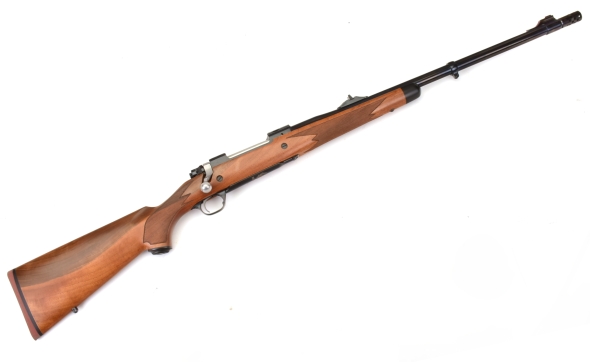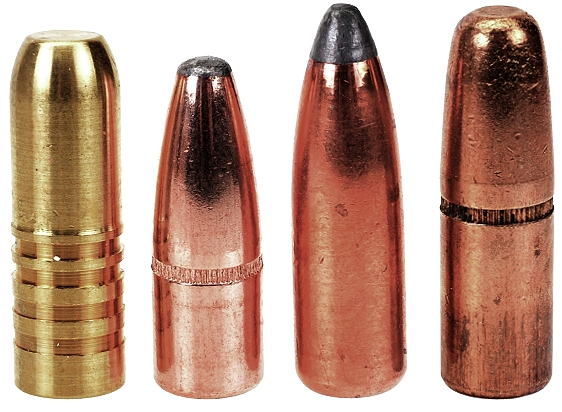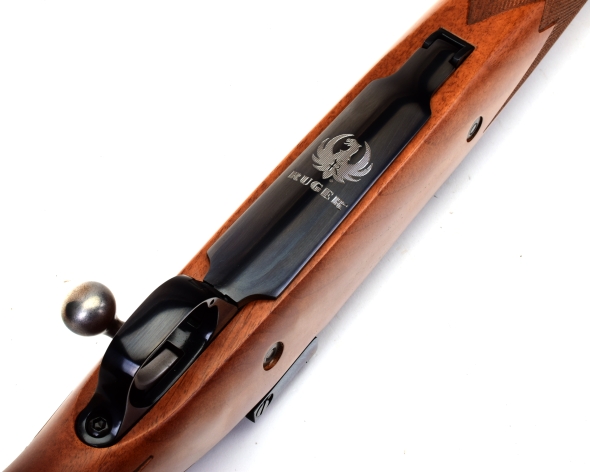
Having the opportunity to spend considerable time shooting Ruger Hawkeye Africans, chambered in all available cartridges, I can say that they all feel about the same. The 300 Winchester Magnum version has the same shooting and handling personality as the 338 Winchester Magnum, 375 Ruger, and 416 Ruger version. At 8 pounds, the African isn’t a featherweight, but it certainly isn’t one of those oversized express rifles that feels like you’re swinging a club when trying to keep moving game in its sights. The Hawkeye African is a well balanced, moderate weight sporter, built to take a pounding.
The 416 Ruger
The 416 Ruger was introduced in January 2009 in the Ruger Hawkeye Alaskan model; a 20″ barrel, stainless steel firearm with Hogue® OverMolded™ stock. The nominal performance was indicated as a 400 grain bullet, with a muzzle velocity of 2,200 fps, generating 4,800 ft-lbs of energy. Currently, 400 grain 416 Ruger ammunition is rated at 2,400 fps and generating 5115 ft/lbs of muzzle energy when fired from a 24″ barrel. To place this performance into context:
| Cartridge | Bullet Weight |
Muzzle Velocity |
Muzzle Energy |
| 45-70 +P+ | 405 | 2000 | 3597 |
| 338 Win Mag | 225 | 2840 | 4029 |
| 375 H&H | 300 | 2530 | 4263 |
| 375 Ruger | 300 | 2660 | 4713 |
| 416 Ruger | 400 | 2400 | 5115 |
| 416 Rigby | 400 | 2415 | 5180 |
| 458 Win Mag | 500 | 2140 | 5084 |
Velocity comparisons seem to trip up rookies, at least those who don’t look closely at the numbers. When lead gets heavy, and this lead is heavy, small increments in velocity yield big time increases in kinetic energy as energy increases at the square of the velocity. The 45-70 along side the 416 Ruger offer good points of comparison. The 416 Ruger is hardy enough to handle the largest game in the world, and do so when fired from a light, fast handling rifle. The 416 Ruger, even without the trailing “Magnum” label, can out perform even the mainstay 458 Winchester Magnum.

Above, the four bullet weights/types used during live fire: 350 Grain Barnes Banded Solid, 250 grain Speer Soft Point, 400 grain Hawk Precision soft point, Hornady 400 grain DGS solid. There are currently 26 bullet types produced by 7 manufacturers for 0.416″ guns that range in weight from 300 – 450 grains including some match bullets. One 420 grain match bullet has a ballistic coefficient of 0.900. The 416 Ruger has the potential of hitting hard and covering relatively long distances.
|
350 Grain Speer Mag Tip Point Blank 255 Yards |
|||||||
|
Yards |
0 |
50 |
100 |
150 |
200 |
250 |
300 |
|
Velocity – fps |
2582 |
2482 |
2384 |
2289 |
2196 |
2105 |
2016 |
|
Energy -ft.-lbs. |
5180 |
4786 |
4416 |
4070 |
3746 |
3442 |
3159 |
|
Momentum -lbs-sec |
4.00 |
3.84 |
3.69 |
3.54 |
3.40 |
3.26 |
3.12 |
|
Path – in. |
-1.5 |
1.4 |
2.8 |
2.8 |
1.0 |
-2.5 |
-8.0 |
The only finicky area encountered when reloading the 416 Ruger was crimping. The Hornady dies are set up for roll crimp and it is quite easy to collapse a 416 Ruger case neck with anything more than a very minor crimp. This is a relatively common problem where shoulders are small and neck diameter is close to case body diameter. This would be a terrific application for a Lee Precision factory crimp die, unfortunately, they do not produce one for this cartridge.
Warning: Bullet selections are specific, and loads are not valid with substitutions of different bullets of the same weight. Variations in bullet material and length will alter net case capacity, pressure and velocity results. Primer selection is specific and primer types are not interchangeable. These data represents maximum loads in our firearms and test equipment and may easily be excessive in other applications. All loads should be reduced by 3%, and developed following safe handloading practices as represented in established reloading manuals produced by component manufacturers. Presentation of these loads does not constitute a solicitation for their use, nor a recommendation.
|
|||||||||||||||||||||||||||||||||||||||||||||||||||||||||||||||||||||||||||||||||||||||||||||||||||||||||||||||
|
|||||||||||||||||||||||||||||||||||||||||||||||||||||||||||||||||||||||||||||||||||||||||||||||||||||||||||||||
Wrap Up
For folks who aren’t recoil shy and like big stoppers, the 416 Ruger is a good one. I have a hard time discerning the difference in recoil between this and a typical 375 H&H, a 7 pound 300 Ultra Mag, or hot loaded and light weight 45-70. The Ruger’s straight stock geometry does a good job of keeping the kick away from a shooter’s face and putting it at contact points best suited to absorb recoil.
I am sure there is more accuracy in this rifle than indicated. Temperatures were hovering around zero, there were light gusting winds and I never did get comfortable at the bench. Then again for a rifle of this type, and the size of a typical target, accuracy recorded is more than enough. Banded solids are made to penetrate in a straight line and do so admirably. Unfortunately, they are as streamlined as a barn door and they take a bit of finesse when handloading; they are approximately 0.001″ undersize and they generate a lot of bore friction. Subsequently, they were not pushed hard.
Overall, in the world of bigger magnums, the 416 Ruger is a good one. It would seem a good alternative for anyone considering a 375 H&H or 375 Ruger as the 416 Ruger delivers a good deal more power with minimal downside. The rifle’s fit and finish are excellent, it is backed by Ruger’s service group and the price makes it a value. Nifty rifle.


Email Notification